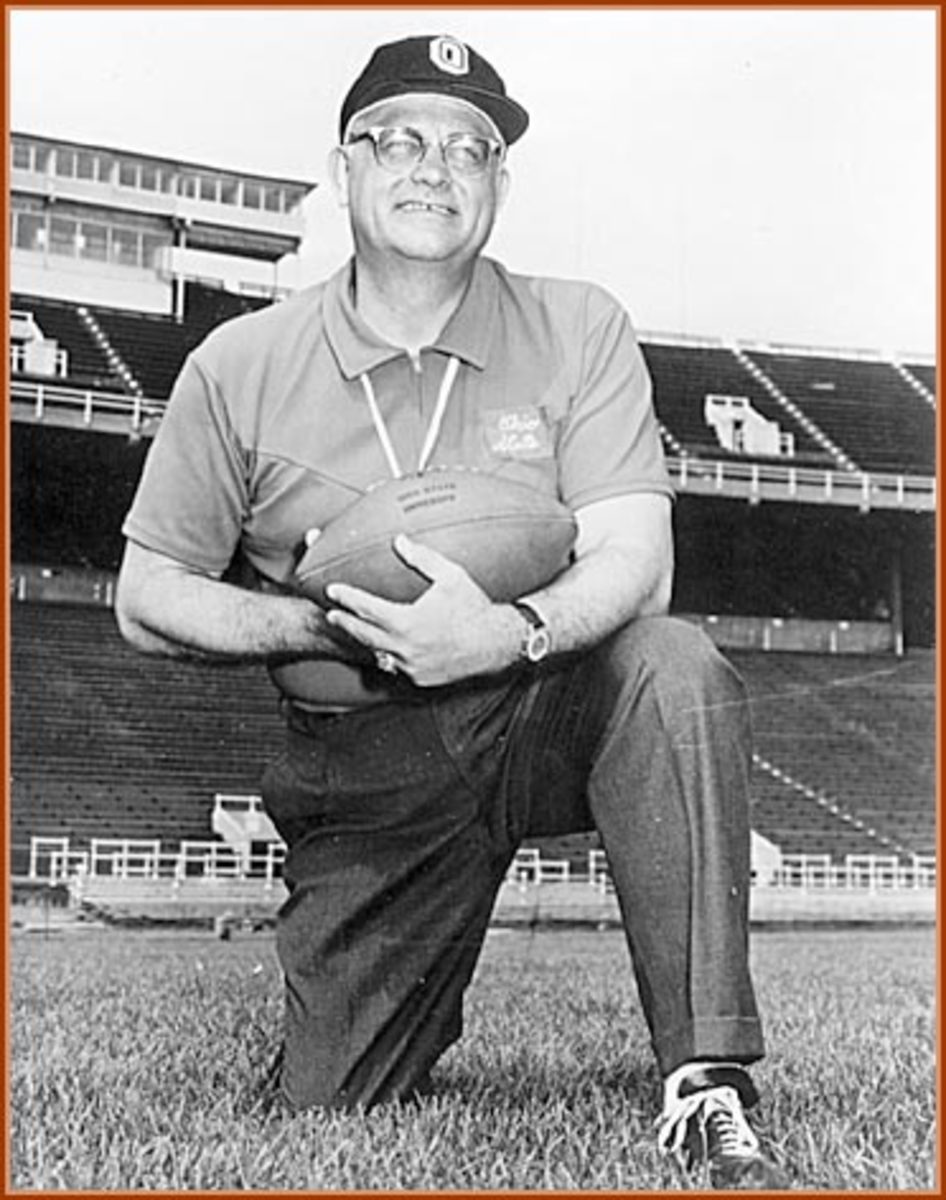Tale of the Coaching Tape: Nick Saban vs. Woody Hayes

Strangely enough, the football program that may have been most responsible for Woody Hayes getting hired at Ohio State was none other than its biggest rival, Michigan.
When they were scheduled to play in 1950, the temperature in Columbus was 10 degrees with winds up to 40 mph blowing snow everywhere. As school officials met before kickoff to discuss the idea of postponing, Michigan’s Fritz Crisler supposedly said, “We’re here and we’re not coming back down next week.”
In front of the 50,000-plus fans who somehow managed to show up, the two sides combined for 68 total yards, with Michigan scoring a touchdown and safety off blocked punts to pull out a 9-3 victory.
After going 0-3-1 against the Wolverines (but 21-10-2 against everyone else), Buckeyes coach Wes Fesler was subsequently fired despite having a ranked team and Heisman Trophy winner Vic Janowicz.
Hayes, who had posted a 19-6 record at his alma mater, Denison, and 14-5 at Miami (Ohio) _ with the 1950 Redskins winning the Mid-American Conference and defeating Arizona State in the Salad Bowl in Phoenix _ was hired over the likes of former Ohio State coach Paul Brown, assistant coach Harry Strobel and Missouri coach Don Faurot.
It was just the first of many controversies surrounding Hayes at Ohio State, as was losing his first game against Michigan, 7-0, but led to arguably the best rivalry in college football, peaking from 1969-78, a period known as the “Ten Year War.”
That particular stretch began when No. 1 Ohio State, which had destroyed its first eight opponents that season, 371-69, and was riding a 22-game winning streak, lost at Michigan – which was coached by former Hayes assistant Bo Schembechler, 24-12.
However, Hayes, one of the most successful coaches in college football history, needed just four years to win his first national title in 1954. During his 28 years, he won 205 games, 13 Big Ten titles and two consensus national championships, with the Buckeyes on the doorstep for three more.
Hayes’ best team was probably the 1968 Buckeyes, who started five sophomores on offense and six on defense, including safety Jack Tatum, nicknamed “The Assassin.” Ohio State upset No. 1 Purdue 13-0, finished the regular season 9-0, and defeated Southern California in the Rose Bowl, 27-16, for the national championship. A total of 11 players from the team earned All-American honors during their careers, and six became first-round draft selections.
Hayes also had two players win the Heisman Trophy, the first being halfback “Hopalong” Cassady, who led the Buckeyes to the 1954 national title and captured the award in 1955. Despite lining up both ways, he had 2,374 career rushing yards and scored 37 touchdowns. Hayes once said Cassady “was the most inspirational player I have ever seen.”
The other may be the most famous Heisman winner in history, Archie Griffin, the only player to win it twice (1974-75).
Although he was just 5-foot-9, 180 pounds, Griffin accumulated 5,589 rushing yards, including an NCAA record 100 or more in 31 consecutive games. Despite this, in 1975 Griffin cast the deciding vote among teammates to name quarterback Cornelius Greene the team’s MVP.
Hayes, who once said, “You win with people,” called Griffin “a better young man than he is a football player, and he’s the best football player I’ve ever seen.”
Griffin is also the only player to start in four Rose Bowls and was named Big 10 MVP twice (1973-74), but not in 1975 when he won his second Heisman. As a sophomore in 1973, Griffin had 1,428 rushing yards (more than he had as a senior, 1,357) and finished fifth in Heisman voting behind winner John Cappelletti of Penn State, while teammate John Hicks, a tackle, was second.

As for his enigmatic coach, the former lieutenant commander in the Navy once declared that “All good commanders want to die in the field,” but his emotions got the best of him in the 1978 Gator Bowl when he punched Clemson nose guard Charlie Bauman after his interception sealed the Tigers’ 17-15 victory. Hayes, who had been a part of numerous incidents before but never with a player, was fired the next day.
Earle Bruce, who went 81-26-1 with the Buckeyes from 1979-87, replaced him. While Bruce couldn’t recapture Hayes' level of success, his coaching tree is one the greatest ever developed, including luminaries like Pete Carroll, Dom Capers, Urban Meyer, Jim Tressel and Nick Saban.
Nick Saban vs. Woody Hayes
(Statistics through 2018 season)
Category Saban ; Hayes
Seasons 23 ; 30
Consensus national titles 6 ; 3
Top five finishes 9 ; 10
Top 25 finishes 16 ; 18
Overall record 232–62–1; 219-66-10
Percentage 78.5 ; 74.7
Losing seasons 0 ; 2
CFP/Bowl record 14-10 ; 6-6
Percentage 58.3 ; 50.0
Conference titles 9 ; 14
Conference record 138-42-1; 159-38-7
Consensus All-Americans 41 ; 26
First-round draft picks 34 ; 27
Record against ranked teams 82-40 ; 41-31-5
Percentage 67.20 ; 56.49
Record against top 10 teams 42-21 ; 23-21-4
Percentage 66.67 ; 52.08
Ratios/percentages
National title seasons One every 3.8 seasons; 10
Consensus All-Americans 1.78 every season; 87
First-round draft picks 1.48 every season; .90
Average wins vs. ranked teams 3.57 each season; 1.37
Wins over top-10 teams per year 1.82 every season; .77
Some of the information in this report was also used in the book "Nick Saban vs. College Football."
